Geyser and hot spring
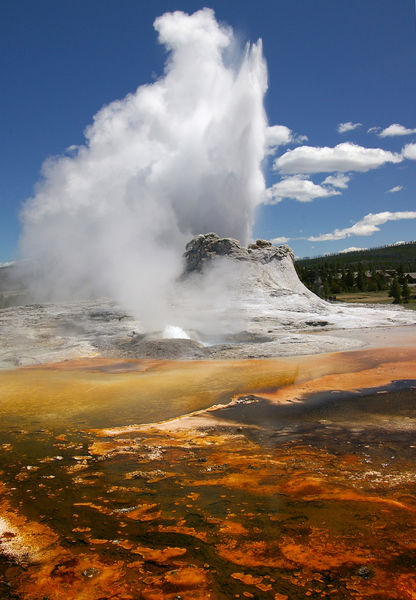
An eponym (pronounced EH-puh-nim) is something or someone that gives its name to everything of its type. In geology, two general landforms derive their names from those of specific examples. Vulcano is the name of an island in the Tyrrhenian Sea north of Sicily. Every volcano on the planet owes its name to this small volcanic island. Geysir (Icelandic for "gusher") is the name of an erupting flow of heated water from the ground in Iceland. The name, in the form geyser, is applied to all such landforms that eject a column of hot water.
Volcano and geyser share more than the fact they derive from eponyms. Both arise as the result of volcanic activity. Whereas volcanoes spew lava (called magma when it is beneath Earth's surface), geysers emit hot water and steam. The activity of geysers is labeled hydrothermal (from the Greek words hydro , meaning "water," and therme , meaning "heat"). Hydrothermal activity also creates hot springs, fumaroles, and mud pots. Some of these landforms emit small-scale eruptions; all are beautiful and delicate.
The shape of the land
A geyser is considered a type of hot spring, which is a pool of hot water that has seeped through a vent or opening in Earth's surface. By definition, the temperature of the water is at least 15°F (8.3°C) warmer than the average temperature of the surrounding air. It can reach as high as 200°F (93°C). Normal hot springs do not erupt, but may seem to churn and "boil" as gases from underground pass through them. When the water that feeds a hot spring passes through rocks underground, it may dissolve minerals from the rocks and bring them to the surface. If those rocks are volcanic, then the water carries silica to the surface. (Silica is the most abundant element found in magma.) At the surface, the water cools and
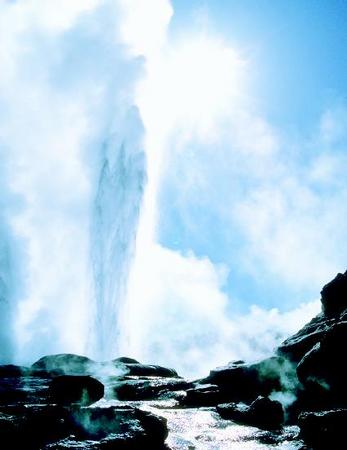
the silica forms geyserite (pronounced GUY-zuh-rite), a white or grayish cauliflowerlike deposit that creates rims or terraces around the spring. This deposit is also known as sinter. If the water passes through limestone, then it carries calcium carbonate to the surface. There the mineral crystallizes to form travertine (pronounced TRA-ver-teen). This dense, white rock also creates ledges and other rock formations around the spring. The water and rocks in hot springs may be multicolored. Brilliant rings of red, blue, brown, green, orange, and yellow are formed by the different species of algae and bacteria that flourish in the hot spring environment.
A geyser is a hot spring that periodically erupts through an opening in Earth's surface, spewing hot water and steam up to hundreds of feet above the ground. Essential geological conditions must be met for a geyser to exist: among other conditions, it must have an abundant water supply, an intense heat source, and a special plumbing system. Because of this, geysers are rare. There are only approximately seven hundred geysers known to exist on Earth. Yellowstone National Park, which lies in northwest Wyoming and extends into Montana and Idaho, contains more than four hundred geysers. The two types of geysers are fountain geysers and cone geysers. As their name implies, fountain geysers erupt like a fountain in various directions through a pool that fills an open crater before or during the eruption. After the eruption, the pool may drain completely into the geyser's vent. Cone geysers erupt in a fairly narrow jet from a vent in a conelike mound formed of geyserite.
A fumarole (pronounced FYOO-ma-role) is a small hole or vent in Earth's surface through which volcanic gases escape from underground. Fumaroles are also known as steam vents because the most common gas they emit is water vapor or steam. These types of hot springs have little water in their system. What does enter the system is boiled away before it reaches the surface. This leaves only steam and small amounts of foulsmelling gases such as hydrogen sulfide (the aroma of rotten eggs) and sulfur dioxide (the initial biting aroma of a lit match). Sometimes as the sulfur dioxide cools when it escapes from the vent, the sulfur in the vapor crystallizes around the vent, forming yellow deposits. The temperature of the gases emitted from a fumarole may reach as high as 750°F (400°C).
A mud pot (sometimes spelled mudpot) is a type of hot spring that contains thick muddy clay. Although mud pots have slightly more water than fumaroles, they also contain the volcanic gases present in the steam vents. In particular, they contain hydrogen sulfide. When this gas combines with water, it forms sulfuric acid. At a mud pot's surface, the acid dissolves the surrounding surface rock, thickening the water with muddy clay. Steam and other gases bubble up through the layers of mud, often explosively so. Mud pots are usually gray or light brownish-gray in color. Sometimes, minerals from the dissolved rocks tint the mud with shades of pink, red, and other colors. When this occurs, the mud pot is also called a paint pot.
Forces and changes: Construction and destruction
Hydrothermal activity occurs around the world, but it is most abundant (and spectacular) in Iceland, the North Island of New Zealand, and in Yellowstone National Park. In these areas, water underground comes in contact with heated rocks and magma, then travels up to the planet's surface through a maze of cracks and fractures, an underground plumbing system. Without this water and this heat, and a way for their creation to reach the surface, these boiling, bubbling, hissing, spewing, spouting, and gushing landforms would never exist.
Geyser and hot spring: Words to Know
- Crust:
- The thin, solid outermost layer of Earth.
- Fumarole:
- A small hole or vent in Earth's surface through which volcanic gases escape from underground.
- Geyser:
- A hot spring that periodically erupts through an opening in Earth's surface, spewing hot water and steam.
- Geyserite:
- A white or grayish silica-based deposit formed around hot springs.
- Groundwater:
- Freshwater lying within the uppermost parts of Earth's crust.
- Hot spring:
- A pool of hot water that has seeped through an opening in Earth's surface.
- Lithosphere:
- The rigid uppermost section of the mantle combined with the crust.
- Mantle:
- The thick, dense layer of rock that lies beneath Earth's crust.
- Mud pot:
- A hot spring that contains thick, muddy clay.
- Plates:
- Large sections of Earth's lithosphere that are separated by deep fault zones.
- Plate tectonics:
- The geologic theory that Earth's crust is composed of rigid plates that "float" toward or away from each other, either directly or indirectly, shifting continents, forming mountains and new ocean crust, and stimulating volcanic eruptions.
- Rhyolite:
- A fine-grained type of volcanic rock that has a high silica content.
- Travertine:
- A dense, white deposit formed from calcium carbonate that creates rock formations around hot springs.
Water under the surface
The thin, rocky outer layer that forms Earth's surface is the crust. Lying within it is a layer of freshwater of varying thickness that fills the pore spaces
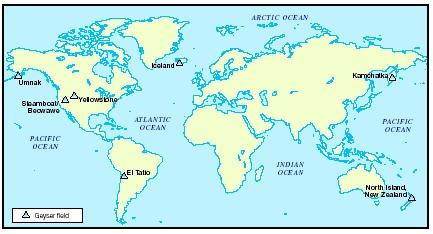
and microscopic openings in rocks and sediment. These openings include the spaces between grains of sand as well as cracks and fractures in rocks. As rain or melted snow seeps through the ground, some of it clings to particles of soil or to roots of plants. Water not used by plants moves ever deeper into the crust, drawn downward by gravity, until it reaches a layer of rock or sediment through which it cannot easily pass. It then fills the empty spaces and cracks above that layer. This water is known as groundwater. The volume of groundwater held in Earth's crust is forty times greater than all the freshwater in the planet's lakes and streams.
The area where groundwater fills all the spaces and pores underground is called the zone of saturation. The top surface of this zone is called the water table. Above it, the pores and spaces in rock hold mainly air, along with some water. This is called the zone of aeration. In places where rainfall is plentiful, the zone of aeration is usually less than 100 feet (30 meters) thick. In certain areas, such as at a pond's edge, the zone of saturation comes to the surface and the zone of aeration has essentially no thickness. In other areas, such as under some deserts, the zone of aeration may extend down from the surface for hundreds of feet before the water table is reached.
Earth's heated interior
On average, the temperature of the crust increases with increasing depth. The temperature of the first 10 to 15 feet (3 to 5 meters) or so of the crust below the surface is the same as the average annual temperature of the external air. Below that, the temperature increases roughly 4.5°F every 330 feet (2.5°C every 100 meters). In the mantle, the thick layer of rock lying beneath the crust, the temperature continues to rise, though not at the same rate. It may do so slowly, or it may do so quickly, perhaps at a rate more than ten times that in the crust. In the core at the center of the planet, temperatures are believed to exceed 9,900°F (5,482°C).
If the heat energy generated by the extreme temperatures at Earth's core were not released in some manner, the interior of the planet would melt. This energy is carried to the surface of the planet by convection currents, the circular movement of molten material deep within Earth. What occurs is similar to what takes place in a pot of boiling water or other liquid. When a liquid in a pot begins to boil, it turns over and over. Liquid heated at the bottom of the pot rises to the surface because heating has caused it to expand and become less dense (lighter). Once at the surface, the heated material cools and becomes denser (heavier) once more. It then sinks back down to the bottom to become reheated. This continuous motion of heated material rising, cooling, and sinking forms the circular-moving convection currents.
Near the core, mantle rocks are heated, becoming less dense and lighter than the surrounding material. They then rise toward the rigid lithosphere (pronounced LITH-uh-sfeer; the upper section of the mantle combined with the overlying crust) at a rate of about a few inches per year. While this occurs, colder, denser, and heavier rocks near base of the lithosphere tend to sink. Near the core, they become heated and rise to the surface once again, and the cycle continues.
The pressure created by the movement of the convection currents under the lithosphere has broken that rigid layer into sections that move about the planet's surface in response to the moving currents. Geologists call these sections plates. The scientific theory explaining how and why the plates move is known as plate tectonics. The movement of the plates—into one another, away from one another, or under one another—has directly or indirectly created (and continues to create) many of the geologic features on the surface of Earth.
Hydrothermal activity: Water and heat
Hydrothermal landforms—hot springs, geysers, fumaroles, and mud pots—are primarily found above areas in the crust where magma or molten rock has risen to a shallow depth beneath the surface. In such instances, the magma may exist in a chamber or reservoir 3 to 6 miles (5 to 10 kilometers) beneath Earth's surface. This magma may be part of heated rock from a convection current or may be part of the leading edge of a plate that has moved under another plate. Geologists called this type of plate movement subduction. It occurs when an oceanic plate moves into another oceanic plate or into a continental (land) plate. Because the oceanic plate is dense, it slides under the other plate. As it travels downward into the mantle, high temperature and pressure melt the rock at the leading edge of the plate, forming thick, flowing magma. Since it is less dense than the rock that typically surrounds it deep underground, magma tends to rise toward Earth's surface. Driven by pressure created by gas bubbles within it, the magma forces its way through weakened layers of rock to collect in magma chambers. Sometimes pressure builds up within the chamber, forcing the magma through cracks or vents onto the surface of the planet. The vents through which the magma passes are known as volcanoes. (For more information on volcanoes, see the Volcano chapter.)
In fact, most hot springs, geysers, fumaroles, and mud pots are found in regions where volcanic activity is very young or has become inactive. In both cases, hot magma does not erupt onto the surface of the planet but exists to heat groundwater that enters the region above it. For example, geologists believe an incredible volcanic explosion 600,000 years ago left a partially molten magma chamber beneath the central portion of present-day Yellowstone National Park. It continues to supply the heat that helps create the many and varied hydrothermal landforms that mark the park. Geologists estimate that rocks in old magma chambers may remain hot for one million years or more.
Ancient Water
The total amount of water that exists on the planet—in the oceans, lakes, rivers, ice caps, groundwater, and atmosphere—is a fixed quantity. That amount is about 500 quintillion gallons (1,900 quintillion liters). Scientists believe this amount has not changed in the last three billion years. The water that existed then exists now.
Scientists estimate the amount of time for groundwater to circulate downward, become heated, and reappear on the surface of the planet in the form of a geyser is about 500 years. The water spouting from geysers in the present day fell to the surface of Earth as rain or snow at about the time Europeans discovered North America. The water gushing from the hot springs in Hot Springs National Park in Arkansas is even older: scientists have determined that this water is over 4,000 years old.
In rare cases, hot springs may exist in areas where magma does not lie close to Earth's surface. Cracks in the crust and mantle may allow groundwater to seep thousands of feet underground. The natural heat of the surrounding rocks, ever increasing at greater depths, heats the water before it makes its way back to the surface.
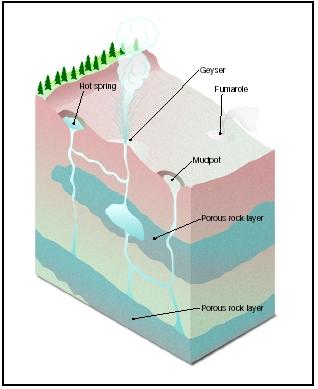
Plumbing systems
Hot springs, fumaroles, mud pots, and geysers all require some type of "plumbing system" to bring water, steam, and gases from several thousand feet underground to the surface. This underground system of cracks and fissures may be relatively open, allowing hot water to bubble slowly and continuously to the surface. Or the system may be restricted, keeping hot water and stream under pressure until it finally spews from the surface.
Hot springs form when there is an abundant supply of groundwater that collects in some sort of reservoir or cavity above heated rock or magma. The water is heated to temperatures exceeding 400°F (205°C). Even though water normally boils and begins to turn into steam at 212°F (100°C), this
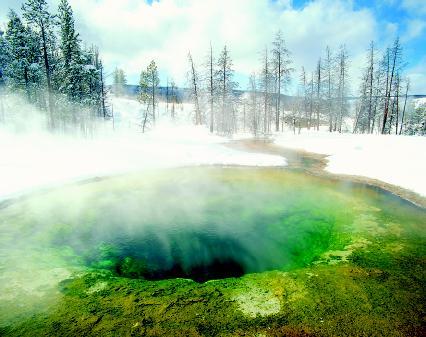
superheated water remains in a liquid state because it is under intense pressure caused by the overlying rock and other groundwater. As the water becomes heated, it also becomes less dense than the cooler groundwater sinking in around it. Convection currents, much like in the mantle, are created that begin to carry the lighter, superheated water to the surface.
As it makes its way upward through its plumbing system, the hot water is able to dissolve minerals from the rocks lining the system. Most often, those rocks are rhyolite (pronounced RIE-uh-lite), a fine-grained type of volcanic rock that has a high silica content. Some of the dissolved silica forms geyserite that lines the walls of the plumbing system (the rest is carried to the surface where it forms geyserite there). This helps seal the system, preventing water from escaping into the surrounding rock. The closer the water is to the surface, the lower the pressure exerted on it. When it finally reaches the surface, the hot water does not burst forth, but merely fills the hot spring pool.
Fumaroles and mud pots differ from hot springs in the amount of water they hold in their plumbing systems. Fumaroles contain the least amount of water. The small amount of water that does collect underground above magma or heated rocks is boiled and converted to steam. The steam combines with gases released by the underground magma and rushes upward, creating a hissing or roaring sound as it escapes the opening at the surface. Mud pots, on the other hand, contain more water than fumaroles, though far less than hot springs. Only some of the water may be converted to steam. The rest rises to the surface in a heated state along with volcanic gases. At the surface, there is not enough water to wash away the sticky clay and mud formed when sulfuric acid dissolves the surrounding rock.
Oldest Geyser
Located in the Upper Geyser Basin area of Yellowstone National Park is perhaps the world's oldest active geyser. Castle Geyser is a cone geyser that erupts every 9 to 11 hours. For the first 20 minutes of its eruption, the geyser shoots out a jet of water to heights between 60 and 90 feet (18 and 27 meters). For the following 40 minutes, it releases a column of noisy steam. The geyser is dramatic even when not erupting. Its geyserite cone stands 12 feet (3.7 meters) high, surrounded by terraces formed of travertine.
Geologists estimate that it has taken 5,000 to 15,000 years for Castle Geyser's cone to reach that height. What is remarkable is that the cone sits on top of an even more massive geyserite formation deposited by an earlier spring. Since geologists believe hot spring activity has been taking place at Yellowstone for at least 200,000 years, it is possible that this underlying formation is that old.
Geysers have the most complex plumbing system. Like hot springs, they have a reservoir that fills with groundwater deep underground. The water is heated by magma or hot rocks, but does not turn to steam because it is under pressure. Unlike hot springs, the water in geysers does not flow freely to the surface. Along a geyser's plumbing system, there are constrictions or bends that block that flow. Unable to flow upward, the water at the bottom is heated even more. Still, it does not completely vaporize because of the weight of the water above it. The steam that is created does flow upward in bubbles, collecting in the system's tight areas when they become too large or numerous to pass through. At a certain critical point, the bubbles then lift the water above, forcing some of it out of the geyser at the surface. This allows the pressure in the system to decrease. With a sudden drop in pressure, much of the superheated water in the system turns quickly into steam, which expands to over 1,500 times its original,
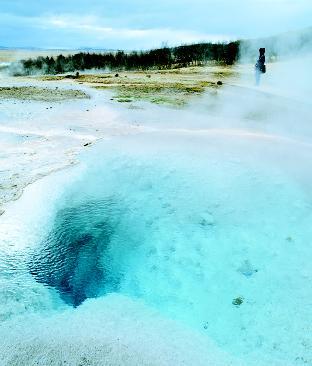
liquid volume. This tremendous expansion forces the water out of the geyser in an eruption. As the eruption continues, the heat and pressure in the system decrease. When the water in the reservoir is depleted, the eruption stops. Groundwater then begins to refill the reservoir, and the cycle begins again.
Temporary features
Providing the groundwater supply is constant, geysers erupt at regular intervals. However, geysers are often temporary features geologically. They do not last for millions of years. They may only last for a few thousand. Along with hot springs, fumaroles, and mud pots, geysers are natural features whose structure may be easily disturbed by changes in the crust. Earthquakes and tremors may shift the ground, changing the flow of groundwater or altering the plumbing system. And, unfortunately, the beauty of these landforms may bring about their destruction. Eager to see an eruption of any type, people have thrown material into the vents and pools. Coins, logs, rocks, blankets, laundry: the list of material is endless. Instead of coaxing an eruption, this has often disturbed the delicate condition under which these landforms exist.
Spotlight on famous forms
Great Geysir, Iceland
The geyser that gave its name to all others lies in a valley named Haukadalur in southern Iceland. A volcanic island (marked by more than two hundred volcanoes), Iceland boasts more hot springs and other hydrothermal activity than any other country. Of the almost eight hundred hot springs on the island, the most famous is the Great Geysir. Geologists estimate that it was created at the end of the thirteenth century when a series of earthquakes shook the valley in which it is located, opening cracks in the ground. After its creation, it reportedly erupted every three hours with thunderous jets of water and steam shooting 200 to 260 feet (60 to 80 meters) above the ground.
The geyser continued to erupt on a regular basis until the beginning of the nineteenth century. From then on, it erupted at progressively longer intervals until 1916, when it stopped completely. It came to life briefly in 1935, but since then has not erupted on its own accord.
Geologists believe that part of the reason Geysir has stopped erupting is due to the accumulation of rocks and other matter thrown into its vent by tourists over the centuries. These objects most likely damaged the geyser's plumbing system. Despite the inactivity of the Great Geysir, the surrounding area remains quite active. Many smaller hot springs surround the geyser, and nearby is another geyser, named Stokkur. It erupts roughly every 10 minutes, shooting a column of water 65 to 100 feet (20 to 30 meters) above its vent.
Hot Springs National Park, Arkansas
Covering more than 5,550 acres (2,220 hectares) of land in Arkansas, the Hot Springs National Park contains 47 natural hot springs. To protect and preserve these springs, the U.S. Congress designated the area a reservation in 1832, and then made it a national park in 1921.
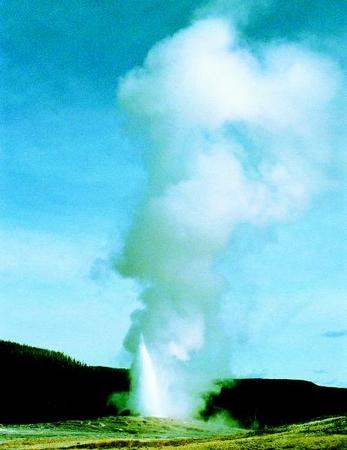
Unlike the water in many other hot springs, the water in the springs of Hot Springs National Park is not heated by underground magma. There is no evidence that volcanic activity has occurred in this area. Instead, the rainwater that feeds the springs has traveled downward to depths between 2,000 and 8,000 feet (610 and 2,438 meters). Here, as groundwater, it is heated by the naturally hot rocks. The heated water then rises quickly—the journey upward takes about one year—through cracks and faults to emerge as hot springs. The total amount of water that comes out of the springs averages about 850,000 gallons (3,217,250 liters) a day.
At the surface, the average temperature of the water in the hot springs is 147°F (64°C). What is noteworthy about the water is that it is sterile: no bacteria are found in it.
Old Faithful, Yellowstone National Park, Wyoming
Although not the biggest or the most regular, Old Faithful in the Upper Geyser Basin in Yellowstone National Park is considered by many to be the world's most famous geyser. It was named in 1870 by members of the Washburn Expedition, the first official expedition to Yellowstone (the park became the world's first national park in 1872). They were awed by the geyser's size and the frequency of its eruptions.
Its eruptions, which last from 1.5 to 5 minutes, spray water and steam from 90 to 184 feet (27 to 56 meters) above the ground. The intervals between eruptions range from 35 to 120 minutes, depending on the length of the eruption. The shorter the eruption, the shorter the interval until the next eruption. At one point, the average interval was every 76 minutes, but earthquakes in the area in the winter in the late twentieth century changed that. At present, the geyser erupts on average every 90 minutes or so, spouting from 3,700 to 8,400 gallons (14,005 to 31,794 liters) of water that has a temperature underground of 204°F (96°C).
Old Faithful is a cone geyser. By measuring the geyserite deposited around the vent of the geyser, scientists estimate that Old Faithful is approximately 300 years old. Before that, the geyser existed as a regular hot spring for several hundred years.
For More Information
Books
Brimner, Larry Dane. Geysers . New York: Children's Press, 2000.
Bryan, T. Scott. The Geysers of Yellowstone . Third ed. Boulder, CO: University Press of Colorado, 1995.
Downs, Sandra. Earth's Fiery Fury . Brookfield, CT: Twenty-First Century Books, 2000.
Gallant, Roy A. Geysers: When Earth Roars . New York: Scholastic Library Publishing, 1997.
Web Sites
"Geothermal Energy and Hydrothermal Activity: Fumaroles, Hot Springs, Geysers." U.S. Geological Survey . http://vulcan.wr.usgs.gov/Glossary/ThermalActivity/description_thermal_activity.html (accessed on September 1, 2003).
The Geyser Observation and Study Association . http://www.geyserstudy.org/ (accessed on September 1, 2003).
"Geysers, Fumaroles, and Hot Springs." U.S. Geological Survey . http://pubs.usgs.gov/gip/volc/geysers.html (accessed on September 1, 2003).
"Infrared Yellowstone Gallery." Infrared Processing and Analysis Center, California Institute of Technology . http://coolcosmos.ipac.caltech.edu/image_galleries/ir_yellowstone/ (accessed on September 1, 2003).
"World Geyser Fields." Department of Geography and Geology, Western Kentucky University . http://www.uweb.ucsb.edu/~glennon/geysers/ (accessed on September 1, 2003).
WyoJones' Geyser Site . http://www.wyojones.com/jonesy/geysers.htm (accessed on September 1, 2003).